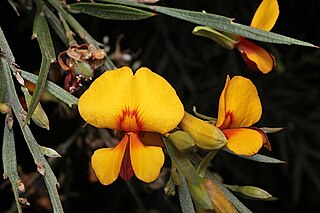
Jacksonia lehmannii is a species of flowering plant in the family Fabaceae and is endemic to the south-west of Western Australia. It is an erect to prostrate or spreading, spindly shrub with greyish-green branches, sharply-pointed side branches, its leaves reduced to scales leaves, yellowish-orange flowers with orange-red markings, and woody, hairy pods.

Jacksonia horrida is a species of flowering plant in the family Fabaceae and is endemic to the south-west of Western Australia. It is an erect or spreading to prostrate, bushy shrub with greyish-green branches ending in short, flattened, sharply-pointed side branches, the leaves reduced to scales and the flowers scattered and yellow-orange with red markings.

Jacksonia acicularis is a species of flowering plant in the family Fabaceae and is endemic to the west of Western Australia. It is an erect, spindly shrub with very sharply-pointed short side branches, leaves reduced to scales, orange flowers with red markings, and densely hairy pods.

Jacksonia angulata is a species of flowering plant in the family Fabaceae and is endemic to the south-west of Western Australia. It is a tufted, spreading to prostrate shrub often with zig-zagged branches, sharply-pointed side branches or phylloclades, leaves reduced to broadly egg-shaped scales, yellow-orange to orange flowers with a red "eye", and woody, densely hairy pods.

Jacksonia arenicola is a species of flowering plant in the family Fabaceae and is endemic to the south-west of Western Australia. It is an erect, broom-like shrub with densely hairy, sharply-pointed phylloclades, yellow-orange flowers with red markings, and woody pods that are hairy at first, later glabrous.
Jacksonia arida is a species of flowering plant in the family Fabaceae and is endemic to Western Australia. It is an erect or prostrate shrub with tangled branches, sharply-pointed branchlets, yellow-orange to orange flowers, and woody pods.
Jacksonia calycina is a species of flowering plant in the family Fabaceae and is endemic to the south west of Western Australia. It is an erect or straggling shrub with sharply pointed end branches, yellow-orange flowers with red and yellow markings, and woody, hairy pods.

Jacksonia compressa is a species of flowering plant in the family Fabaceae and is endemic to the south west of Western Australia. It is an erect, bushy shrub with sharply pointed end branches, yellow-orange flowers with red markings, and woody, hairy pods.

Jacksonia debilis is a species of flowering plant in the family Fabaceae and is endemic to the south west of Western Australia. It is a spreading to prostrate shrub with curved phylloclades, yellow-orange flowers with red markings, and woody, hairy pods.
Jacksonia dendrospinosa is a species of flowering plant in the family Fabaceae and is endemic to the far west of Western Australia. It is a dense, erect shrub or tree with straight, sharply-pointed branches, leaves reduced to scales, scattered yellow-orange flowers with red markings, and membranous, hairy pods.

Jacksonia elongata is a species of flowering plant in the family Fabaceae and is endemic to the south of Western Australia. It is an erect or spreading, spindly shrub with yellowish-green branches, yellow-orange flowers with red markings, and woody, densely-hairy pods.
Jacksonia foliosa is a species of flowering plant in the family Fabaceae and is endemic to the south west of Western Australia. It is a low-lying or erect shrub with sharply pointed end branches, yellow-orange flowers with red markings, and woody, hairy pods.

Jacksonia hakeoides is a species of flowering plant in the family Fabaceae and is endemic to the south west of Western Australia. It is a low, densely-branched shrub with sharply-pointed end branches, the leaves reduced to scales, yellow-orange to orange flowers with red markings, and woody, densely hairy pods.

Jacksonia humilis is a species of flowering plant in the family Fabaceae and is endemic to the south of Western Australia. It is a spreading to prostrate shrub with dull green branches, sharply-pointed phylloclades, yellow-orange flowers with red markings, and membranous, densely-hairy pods.
Jacksonia intricata is a species of flowering plant in the family Fabaceae and is endemic to the south of Western Australia. It is a domed, tangled shrub with copper-coloured branches when fresh, the end branches sharply-pointed, the leaves reduced to scales, yellow flowers with red markings, and woody, densely hairy pods.

Jacksonia macrocalyx is a species of flowering plant in the family Fabaceae and is endemic to the south-west of Western Australia. It is an erect shrub with greyish-green branches, short, sharply-pointed phylloclades, leaves reduced to scales leaves, yellow flowers, and woody, hairy pods.

Jacksonia nutans is a species of flowering plant in the family Fabaceae and is endemic to the south-west of Western Australia. It is an erect, prickly shrub with yellow to greyish-green branches, sharply-pointed branchlets, leaves reduced to triangular scales, orange flowers with red markings, and woody, densely hairy, round or elliptic pods.
Jacksonia pungens is a species of flowering plant in the family Fabaceae and is endemic to the south-west of Western Australia. It is an erect, rounded, domed shrub with greyish-green branches, scattered, sharply-pointed end branches, leaves reduced to dark brown, egg-shaped scales, orange-red flowers with red markings, and woody, densely hairy, elliptic pods.
Jacksonia quairading, commonly known as Quairading stinkwood, is a species of flowering plant in the family Fabaceae and is endemic to a restricted area in the south-west of Western Australia. It is a low-lying, straggling shrub with greyish-green branches, the end branchlets sharply-pointed, the leaves reduced to dark brown, egg-shaped scales, orange flowers with red markings, and woody, densely hairy, flattened elliptic pods.

Jacksonia racemosa is a species of flowering plant in the family Fabaceae and is endemic to the south-west of Western Australia. It is an erect to prostrate, spindly shrub with greyish-green branches, with leaves reduced to scales leaves, yellow flowers with red markings and scattered along the branches, and woody, hairy pods.












